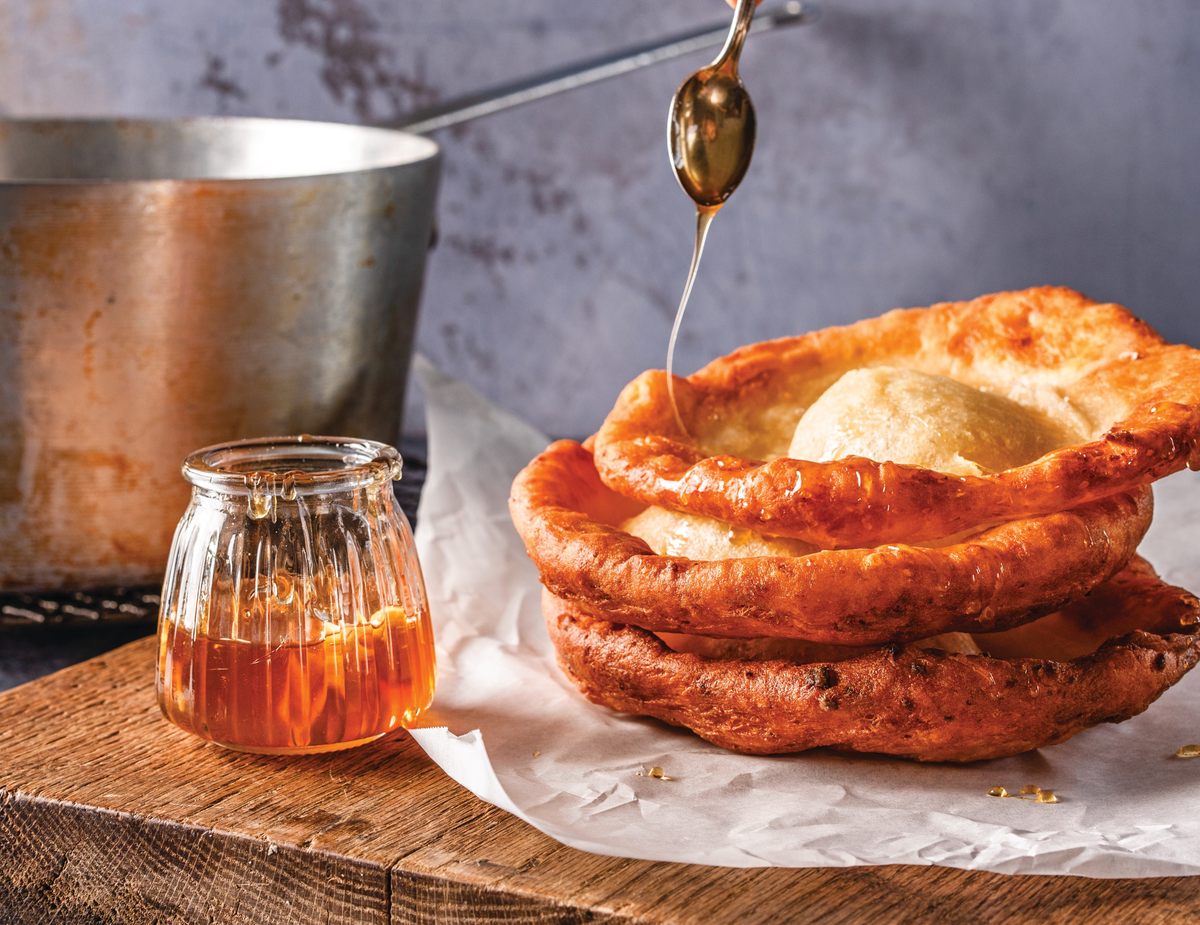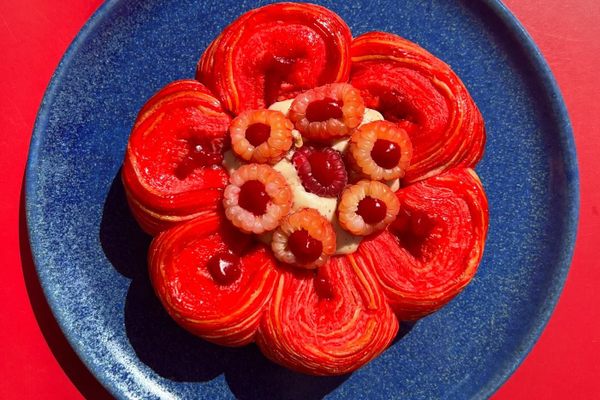

‘Second Generation’ Makes Recipes That Survived World War Sparkle
In his Hungarian-Jewish cookbook, chef Jeremy Salamon of Agi’s Counter digs into his family heritage and uses dill like glitter.
Order palacsinta at any of Hungary’s grand cafés and you’ll receive crêpes neatly rolled around túró (farmer’s cheese) and lekvar (jam). Arranged like fat cigars with perhaps a sprinkle of nuts, the pancakes have an understated elegance verging on austere. But Jeremy Salamon, the chef behind Agi’s Counter in Crown Heights, Brooklyn, first tried these spongy crêpes not in Budapest but in Boca Raton, Florida, where his grandmother made them with a maximalist flair.
Grandma Agi, as Salamon calls his paternal grandmother, transformed the dish into a “DIY party,” where everyone could assemble their own perfect bites from a spread of homemade jams, chocolate sauce, whipped cream, nuts, and sugars scented with cinnamon or rose. And in lieu of bone china, Grandma Agi opted for melamine plates adorned with Walt Disney or McDonald’s characters.
“It was so much fun. You could just go to town and make it really messy and roll it up,” Salamon says. His grandmother’s crêpes are one of 100 recipes in Second Generation: Hungarian And Jewish Classics Reimagined For The Modern Table, his debut cookbook. “It was a very Americanized version of the dish. That’s why I call it ‘Palacsinta Americana.’ A lot of the recipes come from a very personal place and a nostalgic place.”

For Salamon, that place is deeply rooted in his Jewish diasporic upbringing. His Grandma Agi survived both World War II and Stalinist rule in Budapest’s Jewish ghetto. She fled to the United States with little more than a fur coat, ultimately meeting her husband—another survivor from the former Czechoslovakia—at a dance hall. Together they started a dry-cleaning business in Queens, New York, before settling into the ease of a tropical southern clime.
Grandma Agi wasn’t the only culinarily gifted matriarch in the family. “My childhood was a tale of two grandmothers,” Salamon says. “I grew up geographically quite literally in the middle of both their houses. So there would be a Friday night dinner at one house and a Sunday night dinner at the other.”
Both women imparted their food traditions on him at a young age. “Grandma Agi provided the culture of teaching me about Hungarian and Eastern European cuisine and tradition,” he says. Nana Arlene, his maternal grandmother, grew up in a Sephardic family in the Bronx. “She’s the Martha Stewart of the family. She will knit an entire tablecloth for you. She’ll make the flower arrangements, truss a chicken, and make an eight-layer chocolate cake in under 24 hours. I think I took something from each of them.”

Almost all of the recipes in the book are steeped cultural history, yet they wouldn’t all be recognizable in his ancestral homeland. Salamon has visited Hungary regularly for much of his life, but both his cooking and his mindset are rooted in his own experience. “I’m doing everything that I think their government probably does not like,” he says. “I’m a second-generation, American-Hungarian, queer, Jewish-American, doing things with their cuisine that maybe they would turn their noses up at.”
It’s admittedly difficult imagining anyone turning up their noses at lángos (fried bread drizzled with fermented garlic honey), képviselő fánk (“parliament doughnuts,” choux pastry puffs piped full with lemon-scented pastry cream), or szilvás pite, a dimpled, buttery plum cake. “Pastries play a really important role in Eastern European cuisine,” Salamon says. “If you ask a Hungarian, they might tell you that a slice of cake or a torte with a cup of coffee or tea is really a meal in itself. It’s a part of the day. That’s why they have these grand cafés in Europe because you’re supposed to go and sit and have that whole experience.”

Flódni, dobos torte, and other baroque, many-layered extravagances are conspicuously absent from the book—in part because even Hungarians tend to leave them to the professionals. “If you make one mistake, it’s a tragedy,” Salamon says of flódni, an Ashkenazi layered cake with walnuts, poppyseeds, and apples bound with plum jam. Here, he sticks to recipes even anxious home bakers can master with a little coaxing. Precise, gently encouraging instructions urge readers to tackle even recipes that might seem daunting, such as the coriander-crusted beef tongue.
“I was very adamant about putting a recipe for beef tongue in the book,” he says, even though his publisher was initially less enthusiastic about the idea. It’s a stalwart of Jewish delis everywhere, but it requires real skill to execute properly. “You can absolutely overcook it and it would be super tough. Nobody wants a rubber-y tongue.” Here, it’s deliciously tender, ideal for piling on slices of caraway pullman bread, or according to Salamon, piled high on a Caesar salad after a long night of drinking.
Convincing readers to cook beef tongue might seem tricky, but Salamon is no stranger to challenge. When he opened Agi’s Counter in 2021, an Eastern European restaurant was a tough sell. As he describes it, much of the global perception of Hungarian cooking centers on “goulash and paprikash and these things that sound like you have peanut butter stuck on the roof of your mouth.”

Even Salamon mostly associated Hungarian cuisine with meat-and-potatoes cookery, until he stumbled across a battered copy of The Cuisine of Hungary by George Láng in a bookshop. Láng was a restaurateur, Holocaust survivor, food journalist, and de facto culinary ambassador for his country. Over his long career, he purchased and restored Gundel, one the most famous restaurants in Budapest, and ran Café des Artistes in New York. His cookbook is a historical magnum opus, with hundreds of pages expounding on the gastronomic heritage of Hungary, as well as a trove of exhaustively researched recipes.
In Láng’s book, Salamon saw a radically different take on the cuisine he thought he knew. “When you peel back the layers, I was shocked to find that there was so much color to it,” he says. Alongside the rich, savory stews and hearty roasts, he saw bushels of herbs, fresh fruits, edible flowers, and endless pickles. “Hungary has been so influenced by so many tragic events,” Salamon says. “But in the process, its food has been pulled and stretched in different directions to create something that is, I think, uniquely its own.”
Freshness and color permeate his own book, where pops of orange salmon roe, fuchsia sour cherries, and emerald sprinkles of dill punctuate the pages. “A friend told me, “You should call the book ‘Big Dill,’” Salamon says. “We really love dill here at Agi’s Counter, so much that we compare it to glitter. It just gets everywhere. You go home with it. It’s in your underwear. It’s in your shirt. It’s stuck to you in the oddest places.”

As in his own life, the love of family and food are inextricably bound in these pages. In a nod to his Grandma Agi, Salamon includes scrawled handwritten notes next to many of the recipes. When he left for university, she would tear recipes out of magazines and mail them to him, inevitably covered in sidebars and substitutions.
“She used to be like, ‘I found this recipe from Ina Garten, but I’m thinking that it would be better like this,’” he says. His own version of the notes are both a callback and a reminder that cuisines are rarely set in stone. “I want people to know there’s options. It’s not just a one-and-done recipe. It could evolve into more than what I’m telling you.”
Ultimately, Salamon’s work is as much about generational transformation as it is about nostalgia. Several centuries of often painful history inform these recipes, even if they feel rooted in the present. “Her journey and her experiences really evolved her perception of the cuisine,” Salamon says. “I took her concept of this American-Hungarian cuisine, and I just moved it forward in my own way. That’s a romantic way of looking at it.”
Palacsinta Americana
Adapted from 'Second Generation' by Jeremy Salamon
- Makes 12 crêpes
Ingredients
- 4 cups all-purpose flour
- 4 cups whole milk
- 1 ¾ cups cold seltzer
- 8 large eggs
- 1 ½ tablespoons pure vanilla extract
- Kosher salt
- Unsalted butter, for greasing
- Toppings such as fresh farmer’s cheese, candied walnuts, chocolate sauce, cinnamon sugar, caramel sauce, fruit compotes or jams, and whipped cream for serving
Instructions
-
Whisk together the flour, milk, seltzer, eggs, vanilla, and a big pinch of salt in a large bowl. Let the batter rest in the refrigerator for 30 minutes to set.
-
Set an eight-inch crêpe pan or nonstick skillet over medium-high heat. Add a small scoop of butter to the pan, tilting to cover the surface. Ladle the crêpe batter onto the pan, tilting so the batter covers the entire surface. Don’t be afraid to add a little more batter if it needs it
-
Let the first side of the crêpe cook for about two minutes. You’ll know to flip when the sides of the crêpe begin to peel up off the pan. Using a spatula, flip the crêpe over and continue to cook on the other side for less than a minute. The result should be a golden-brown crêpe that looks like it has craters spattered about it. Your first crêpe will most likely be a throwaway and that’s normal. Every batch should get a practice run.
-
Continue with the rest of the batter to make 12 crêpes, stacking each one on the plate as they’re done.
- Serve the palacsinta with toppings such as fresh farmer’s cheese, candied walnuts, chocolate sauce, cinnamon sugar, cherry caramel, fruit compotes or james, and whipped cream. Allow everyone to assemble their own.
Gastro Obscura covers the world’s most wondrous food and drink.
Sign up for our regular newsletter.























Follow us on Twitter to get the latest on the world's hidden wonders.
Like us on Facebook to get the latest on the world's hidden wonders.
Follow us on Twitter Like us on Facebook